The pandemic has put weight behind long-time argument to protect open spaces. An expert panel suggests smart tweaks for Mumbai's urban infra while we still have the time
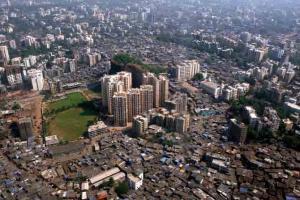
A city starved of open spaces, says the Urban Development Research Institute, is threatened by a Development Plan for 2034 that further dilutes layout open spaces, a real hazard in a post-COVID world. Pic/ Getty Images
In India, the social distancing measures announced have meant jugaad-style appropriation of streets. In efforts to direct social distancing while queuing, sidewalks leading to shops have been marked with yellow circles a meter-and-a-half apart." Thus, reads a mention of Mumbai's efforts to battle the Coronavirus in a research paper titled, The Impact of COVID-19 on Public Space: A Review of the Emerging Questions. Published in April, and available on ResearchGate, the paper has been produced by co-authors located across the world and addresses what a post-lockdown world might look like. What's of particular interest is what stepping out of the lockdown, while still trying to fight a highly infectious, fatal disease, means for Mumbai, that has no room to manoeuvre.
The first signs that the government—city, state and country—was going to implement a strict lockdown, came when Mumbai's suburban rail network shut down. This would be the first time in its 167-year-old history that no suburban trains have run in the city for this long. And, when services do start, the first question to be addressed is how do you reduce crowds on a service that transports lakhs of people daily?
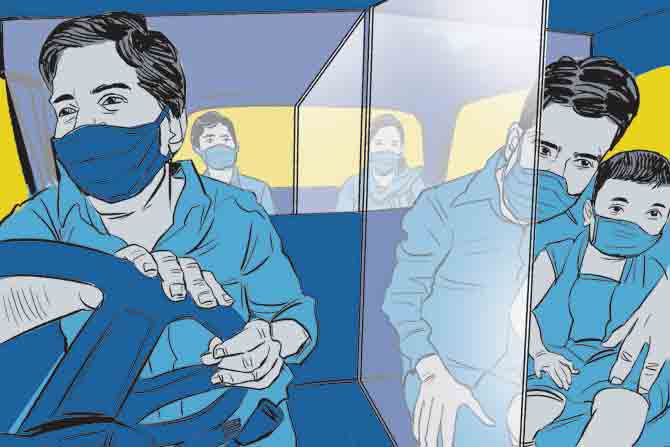
Illustration/ Uday Mohite
Transport expert Ajit Shenoy says, "The government needs to ensure that the number of people using this public system does not come back to the original level, which was 75 lakh. This can no longer happen," he stresses, adding that an odd-even scheme, where "50 per cent of the working population goes to work on one day, and the remaining the next day" should help. "Video conferencing has caught up now; let's make that a way of life. Those who can work from home, should, and those who need to be physically present, like manufacturing staff, can work on fewer days of the week."
Chairman of Mumbai Environment Social Network, Ashok Datar, agrees that the city needs to change how it works in order to change how it commutes. "The infrastructure doesn't need to be overhauled, but small tweaks are essential. Had people in Mumbai managed to work closer to their homes, we wouldn't have this challenge on our hands. But, our homes are at one end of the city, and workplaces at the other. Densification—equal distribution of people across different areas—is the need of the hour."
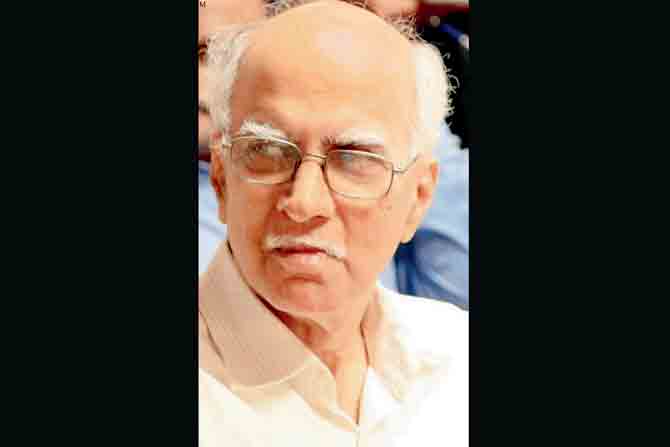
Ajit Shenoy
Shenoy believes that in order to reduce the load on public transport systems, it should be made mandatory for people to use cycles or take to walking in cases of commuting short distances. "Only those travelling long distances, should take trains and buses. All of this with the general rule of wearing masks and using sanitisers, of course."
In addition to personal solutions such as these, some European countries are also testing the utility of glass cubicle seating arrangements inside buses. While that might seem like a quick solution, Datar points out that installing glass cubicles in trains, would convert a 90-feet, 290-seater coach into a 45-seater. "We cannot afford such fancy mechanisms."

Ashok Datar
However, partitions like these may work in the case of smaller transport units, such as autos and taxis. On May 14, Uber announced that it is working to install partitions between driver and commuter in 400 cars in Newcastle, Sunderland and Durham in the UK. Pankaj Joshi, executive director of the Urban Development Research Institute (UDRI), says this can be replicated in Mumbai. "Such dividers will protect drivers from coming in contact with passengers, and vice versa," he adds.
Another solution, says Joshi, is to connect the city better to ease the load on railways and buses. "How did Shanghai do it? It took a 5,000 sq km land area around it and expanded the city. Mumbai has already expanded the city; it does not stop at Mulund or Virar; it goes far beyond till Pen and Palghar. If these areas are connected with trans harbour trains or metros, why would anyone want to live in Andheri and Kandivli anymore? People will buy homes on the outskirts and travel within 30 minutes to work."

Looking at how migrants working in Mumbai, who boarded state buses to get back home, were seated cheek by jowl, Datar points, "It has to be mandatory that one person sits on one seat. We can ensure that a limited travelling population is taken on board buses only when a seat is available."
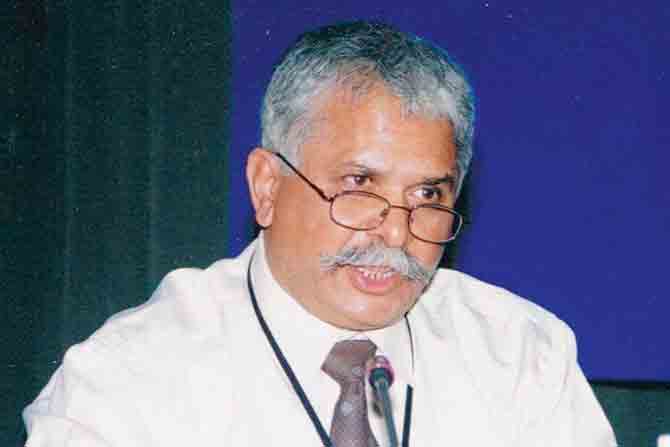
RK Dave
RK Dave, former senior specialist (Policy and Plans), National Disaster Management Authority (India), suggests that crowd management principles be used to allow for social distancing. "Even in trains where there are unreserved coaches, the government will have to issue non-reserved tickets and the moment the capacity is full, issue of tickets should stop automatically. This will allow for a certain minimum physical distance, and capacity can change depending on whether there is an outbreak or not." He adds that another measure is to prevent crowding on the station premises. "Just as you are not allowed to enter the IGI airport in Delhi more than four hours before the flight, it should be mandated that a passenger should appear at the entrance of the station gate only an hour before departure. But, to ensure this works smoothly and there is no last-minute scramble, trains have to arrive on time and when they are on the platform, people should be able to get into the coach immediately, and not have to wait for it to be cleaned." He also adds that all hawkers should be removed from platforms since they are crowd pullers. Multiple entrances and exit points at railway stations are no longer feasible. "Keep two available for citizens, and there too, a designated person needs to check temperature of every passenger. If this is done in phases, we can definitely relax some lockdown rules in a few months," Shenoy believes.

Transport experts believe it's no longer viable for 75 lakh commuters to take the local trains every day without being an infection spread hazard. An odd-even scheme, where 50 per cent of the working population goes to work on one day, and the remaining the next day" should help. Pic/ Getty Images
But, architect, urbanist, and associate professor at the Indian Institute of Technology, Mumbai, Himanshu Burte, hopes that the original life of Mumbai's streetscape isn't destroyed. How the street is perceived will also define how people move in a post-lockdown Mumbai. "People's lives depend on the street and they need to be kept functioning in a way that vending can happen. In fact, the street is often the only place available for half our population, which lives in congested slums, to come out and maintain minimum distance. The complexity of the street problem was not being addressed earlier, but it needs to be done now."

The Dadar flower market is one of the most busy in Mumbai. Urban planners say that people's lives and livelihood depends on the streets and despite social distancing, vending needs to continue to happen. Pic/ Getty Images
Burte points out that a huge percentage of trips made to work happen by walking, by either those who can't afford to travel long distances and choose workplaces nearby, or those who walk from the station to home or office. Thus, to prevent crowding here, while widening the footpath might not be possible, discouraging car usage and encouraging mass transport would work. For instance, an office providing a pick-up bus for its employees. "When cars are parked, a significant amount of road width is consumed permanently by parking. Additionally, wherever a car is parked next to a footpath, people are discouraged from walking on the pavement, so you have lost the footpath as well." He adds that minor repairs of footpaths will make them operational. "Even if a small stretch is broken, people avoid it and it becomes unused. The crisis is an opportunity to move decisively away from the car-centric transport city this has been."

Illustration/ Uday Mohite
Interestingly, there is a connection between work from home and the use of open spaces. According to the Impact of Covid-19 on Public Space… paper: "In cities with stay at home orders, we have observed more use of green spaces, especially the small neighbourhood parks, which seem to be undergoing a renaissance (van der Berg, 2020)." It next asks, "Will planners begin to prioritize the design of smaller local, neighbourhood green spaces?"

A file photo of commuters trying to catch a bus outside Andheri station. Transport analysts say that only a limited travelling population can be allowed on buses, and availability of sanitisers should be made mandatory. Pic/ Getty Images
While the stereotype is that Mumbai has fewer open spaces, Burte argues that a report commissioned by MMREIS (Mumbai Metropolitan Region Environment Improvement Society), founded by MMRDA, the government body responsible for the infrastructure development of the Mumbai Metropolitan Region, found that in terms of availability or accessibility, the city does have open spaces, even though they may not be large, within five to 10 minutes of their homes. "The problem is that a large proportion of open spaces are not maintained. Also, minor design interventions can improve usability. This could be a possibility for those who wish to go for a walk, or for kids to play."
While rooftop gardens have been offered as a solution in the paper, it is not a solution that can be copy-pasted to Mumbai.

Santosh Wadekar
Santosh Wadekar, an interior architect who heads a boutique firm called studioSW, says leakage is an issue in 70 per cent of Mumbai's buildings. With humidity as a constant, and the sea as a neighbour, the steel in the building frames expands, causing cracks in the concrete. "Also, the question is that whether you place planters or a layer of soil on the terrace, has your building been designed for this additional deadload? Such issues have been taken care of in the newer buildings, however." The best solution for Mumbai, he says, is balconies where people can place their greens, and also use it as a semi-public area where you are not physically mingling with others, but can still interact with them.

UDRI approached Mumbai-based photographer and filmmaker Abeer Khan to shoot a short film on the dilution of open spaces in the city. The film, which released on YouTube early this month, looks into the various Development Control and Promotion Regulation (DCPR) 2034 dilutions brought about by the government. Joshi explains, "The film looks into the implications of erroneous provisions of the DP 2034, now even more important in light of the outbreak of Coronavirus, where maintaining a safe distance will become the new norm. Our film's focus is specifically on layout open spaces like podiums in buildings. In 2012, the SC had ruled that podiums/grounds need to be in the open and not built on concrete. But the last government overturned this through the DCPR. These open grounds are crucial for rainwater percolation. But if we build them on concrete, areas will face more water-logging and extreme flooding during monsoon, resulting in a spike in various other infectious diseases. Therefore, the DCPR needs to be corrected. The current government should take a look at it and earn political brownie points, too."
Wadekar, who on Friday spoke at a webinar on the implications that COVID-19 has on the future of the home automation industry, addresses the issue of touch. Even in a semi-private area such as an office, we are constantly touching surfaces to switch on lights, open doors or take an elevator. But now, light sensors will activate the light when you are in the area, without having to touch the switch board. A voice activation can take you to your 19th floor office and a handheld device will allow you to open a push/pull door without touching. "Earlier, the sensors were made for the West and needed to be kept dust-free, which is not possible in Mumbai. But, recently, local companies have started making good automation tech, which is cheap and suitable to Indian conditions, and spaces can be retrofitted to this tech."
![A file photo of BIT Chawl near JJ Hospital in south Mumbai. Rupali Gupte, professor at the School of Environment and Architecture, argues about the ineffectiveness of the lockdown policies by defining the limits of a home to the front door, when in fact “most people don’t have those [2BHK] homes.” PIC/GETTY IMAGES](https://images.mid-day.com/images/images/2020/may/jugaad-h.jpg)
A file photo of BIT Chawl near JJ Hospital in south Mumbai. Rupali Gupte, professor at the School of Environment and Architecture, argues about the ineffectiveness of the lockdown policies by defining the limits of a home to the front door, when in fact "most people don’t have those [2BHK] homes." Pic/ Getty Images
Contactless technology will also be useful while commuting.
Shenoy suggests an e-ticketing system for both buses and trains. "Swipe cards can be used to record entries once you board. A regular fare can be deducted from your account once you alight. While sitting inside a bus, there are chances of physical contact, so sanitisers need to be made available everywhere." If people want to step out during an emergency, on the day they are supposed to be home, they can be handed passes.
Much like etickets for trains, Dr Dave suggests issuing e-tokens for temples and other places of worship. "If digital worship can work, it should be implemented, but not many will take to it. In such a case, e-tokens are the best way to control the rush." For shopping complexes or markets, he points out to a system being used in Ottawa, Illinois, where he currently resides. "In a shopping mall, from the entrance, arrows on the floor point out the flow of visitor movement along the aisle. Even if what I want to buy is in the third aisle, I cannot jump across. I will have to follow this path. What this implies is that two people are never face to face in a market. However, only the government can implement such measures. The private sector needs to show willingness."
While addressing congestion on the roads, on locals and in malls as part of Mumbai's post-lockdown measures, social distancing will fail if the government doesn't stop to consider the city's diversity.
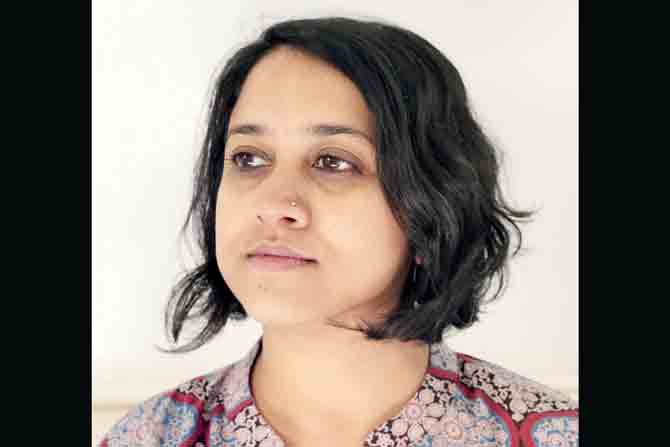
Rupali Gupte
Rupali Gupte, professor at the School of Environment and Architecture, argues about the ineffectiveness of the lockdown policies by defining the limits of a home to the front door, when in fact "most people don't have those [2BHK] homes." If the home is in a chawl, for instance, often the idea of the homeness extends beyond the threshold, into corridors and the street. Can, then, a neighbourhood be looked upon as one unit?
Gupte and conservationist architect Kiran Kalamdani, also wants future policies to address decongestion of slum areas such as Dharavi. "They have common toilets for a population of thousands. This is where an infection is picked up. We need to individualise toilets or keep them restricted to a certain numbers of families. And, this needs to be done on war-footing," Kalamdani says. He adds that building SRAs for slum dwellers is a "rotten and flawed concept". "People say most of the slum development has gone wrong because of the architect. But that is not the case. It has gone wrong because of economics. Economy drives them to compromise these living spaces. Housing in slums has to organically evolve. Let them undertake self-redevelopment without roping in a developer. Don't let architects design their homes; empower the community with NGOs and other resources to build their own homes."

Kiran Kalamdani
Joshi points to Mankhurd and Mahul where buildings are merely 10 feet apart with a large population suffering from tuberculosis due to lack of ventilation and space. "From 1995 till date, we have built 1.5 lakh houses for slum dwellers when the requirement is for 15 lakh homes. It's time we learn from
our mistakes."
Gupte says that the idea of the living space should be extended to the city, and not sequestered to a house. Parks and gardens should be made accessible for all. Even BMC parks, she points out, are shut in the afternoon and at night, limiting their use. "In Brazil, a tax is collected from workers of a city and invested back into community spaces. There are large spaces right in the middle of the city. In Sao Paolo, these have been built on old mill lands. You have libraries, workshop areas and kitchen spaces. Distancing can't happen at home, but social distancing can happen outside as well. We have so much mill land, right in the middle of the city, but it's a lost cause."

Kaiwan Mehta
Kaiwan Mehta, architect, academic, researcher and author of Alice in Bhuleshwar: Navigating a Mumbai Neighbourhood, adds, "What is our notion of the house? It's a very middle-class imagination and every television advertisement has the same vision. But Mumbai alone has different types of homes. And most don't have a large double bed with a TV on which someone is playing a game. There are no different rooms for different people."
The migrant crisis, he adds, has highlighted that we think of cities as stagnant spaces, with people living and dying in the same area. And, yet, a large population in the country doesn't have a sedentary lifestyle. "We need to understand the different kinds of people and cultures that live in a city. And no design intervention will be effective unless we take into account the mental life of the city Everyone has a different notion of time, space and safety. [Protection from] The virus, right now, is perhaps the least of a migrant's problems. And that includes the woman concerned for her physical safety while walking the highways for 14-15 days."
Catch up on all the latest Mumbai news, crime news, current affairs, and a complete guide from food to things to do and events across Mumbai. Also download the new mid-day Android and iOS apps to get latest updates.
Mid-Day is now on Telegram. Click here to join our channel (@middayinfomedialtd) and stay updated with the latest news
 Subscribe today by clicking the link and stay updated with the latest news!" Click here!
Subscribe today by clicking the link and stay updated with the latest news!" Click here!









